Where it occurs: In Northern and Central America, Europe, and Southern Russia.Jimsonweed resembles potatoes or tomatoes, which is not surprising because it’s their close relative. It is an inconspicuous plant with thorny capsule fruits that have black seeds inside. Its white flowers emit a stupefying smell.
Why it is dangerous: It contains alkaloids that cause palpitations, disorientation, and delirium. In severe cases, death or coma are possible. Shamans of many peoples used this plant in their rituals.
5. Hogweed
Where it occurs: In temperate regions of Eurasia. One species grows in the USA.It’s a giant and rather impressive-looking plant, but be careful not to take photos of yourselves next to it.
Why it is dangerous: Some species contain furanocoumarins that cause painful blistering under sunlight. If some hogweed sap gets on your hand, wash it and protect it from sunlight for about 2 days.
4. Spurge

Where it occurs: Everywhere. It can often be seen even in our houses.A huge number of species belong to the Euphorbia genus. They are often very different: some look like cacti, others like flowers. Teach your children not to touch unfamiliar plants, even if they grow in pots.
Why it is dangerous: The sap leaves blisters, later joined by indisposition, swellings, and fever.
3. Rhubarb

Where it occurs: Cultivated in Europe, Russia, and the USA.In many countries, rhubarb is used to make pies, salads, and sauces. Some even like to nibble on its raw stalks.
Why it is dangerous: Not everyone knows that the leaves and root of this plant are not to be eaten because they contain a huge amount of oxalic acid. They can cause burning in the throat and eyes, kidney stones, nausea, and diarrhea.
2. Belladonna

Where it occurs: In Northern Africa, Europe, Southern Russia, Asia Minor, and parts of North America.
Belladonna looks like a bush with black berries and pinkish flowers. It contains atropine, an alkaloid causing pupil dilation. In the Middle Ages, belladonna drops were used to make the eyes more attractive. Today similar drops are used during eye operations.Why it is dangerous: Mild poisoning leads to palpitations and dryness and burning in the mouth. Severe poisoning causes complete loss of orientation and sometimes cramps and death.
1. Castor Bean
Where it occurs: In tropical, subtropical, and temperate zones. Because of its unusual appearance, it is grown as an ornamental plant.Unsurprisingly, castor beans are used to make castor oil. But don’t worry: heat treatment destroys all the toxins.
Why it is dangerous: Possibly the most dangerous plant there is. It contains extremely toxic compounds: ricin and ricinine. The seeds are particularly deadly: eating only 4-7 of them will lead to death. Smaller doses cause irreparable harm to health since ricin destroys body tissues.Bonus: Venus flytrap
This curious plant is hardly able to kill you, but doesn’t it look like something from a horror movie?
courtesy: bright side
